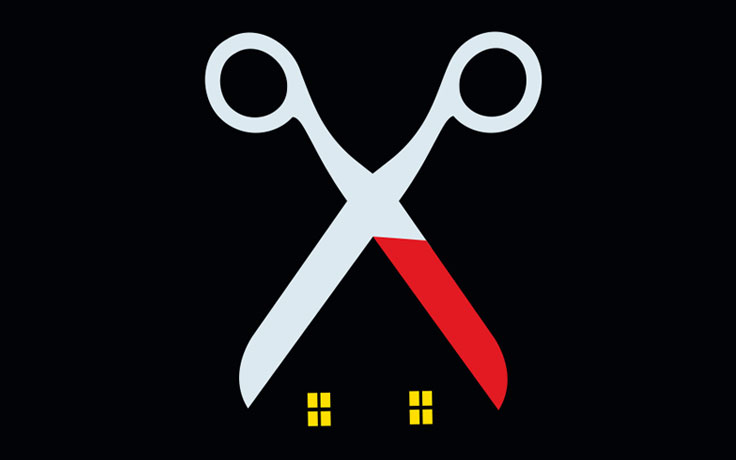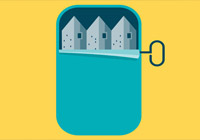EVERY MORNING, Natherine wakes up with knots in her stomach, worried about how she will pay the rent. “I have lost my appetite,” she said. “I can’t eat half the time. The stress is beyond belief.”
Even before the pandemic, the South Pasadena resident, who asked that her full name not be used, was struggling financially. Natherine, 62, has been largely out of work for much of the past 18 months because of health issues and, more recently, COVID-19 concerns. Now, the prospect of losing her housing is a terrifying possibility.
“I’ve never ever missed one rent payment in the almost 11 years I’ve been here. My first missed payment was in December,” she said. “I had some savings — I can’t do anything but pat myself on the back that I managed to have some savings to carry me through. I’ve got maybe one more month of rent, and after that, then what?”
Natherine’s situation is not unusual. Since the COVID-19 pandemic hit, millions of people across the country have faced illness or job loss that has made it difficult to pay their rent and has left them in jeopardy of eviction. For thousands living paycheck to paycheck, the pandemic has added a new level of stress to their already tenuous situations. Desperate tenants are draining their savings accounts or further amassing debt by seeking loans from friends and family or using credit cards to pay their landlords.
Federal, state and local governments are providing some rental assistance or enacting “eviction moratoriums.” But in many cases, the payments are not enough or arrive too late and still leave tenants in precarious positions that may only delay an inevitable displacement. Some housing officials fear that Los Angeles, which has more than 2 million renter households, could face a flood of evictions once the moratoriums run out and rent repayment comes due.
Struggling to pay rent
A 2020 UCLA-USC STUDY FOUND that 1 in 5 renters in Los Angeles was unable to pay rent on time during the early months of the pandemic. About 7% — which translates to about 137,000 households — were unable to pay any rent at all for at least one month during that period. And those numbers are unlikely to improve in the near future.
“On the one hand, the numbers are surprising because you see the amount of lost work and lost income. On the other hand, it’s not that surprising, only because housing is just so important — people are resilient and in the sort of hierarchy of needs, people will give up a lot to make sure they still have a roof over their head,” said Michael Manville, associate professor of urban planning at UCLA’s Luskin School of Public Affairs and one of the study’s authors. “They may forgo a lot of other expenses. They may borrow from their families; they may go into their savings. Even people who didn’t report being late did report this uptick in using credit cards and family members and savings to help pay.”
Expanding on a Pulse Survey by the U.S. Census that mea- sured how lives were impacted by COVID-19, Manville, along with UCLA associate professors Paavo Monkkonen and Michael C. Lens, and Richard K. Green, a professor and director of the USC Lusk Center for Real Estate, conducted their survey of 1,000 people to gauge renter distress in Los Angeles during May, June and July 2020. They are currently analyzing data from a second survey, which covers later months of the pandemic.
“We were interested in how many people were not paying, how much trouble renters are having and what factors seemed to be associated with that,” Manville said. “And we were interested in its consequences. Eviction is the biggest and most dire consequence, but there are other consequences as well.”
At the Los Angeles-based Housing Rights Center, one of the oldest and largest nonprofit fair-housing organizations in the country, Natherine’s situation is an everyday reality. The center provides education and legal assistance to tenants throughout the county and administers the Emergency Renters Assistance program for the city of Los Angeles, which last year issued more than $103 million in rental assistance, with payments going to more than 49,000 tenant households.
Chancela Al-Mansour, executive director of the center, said she recently spoke with a landlord who came to the center’s Koreatown office to pick up rental assistance checks on behalf of her tenants. “She has tenants who owe $20,000 in back rent,” Al-Mansour said. “$20,000! And we’re not talking about luxury apartments.
“Under normal bad times, you may have one person in the household who has lost their job. Many of these situations are in families where everybody in the household lost their job,” she said. “People are feeling it, and calls are definitely more desperate now: ‘I really have no money at all. I’ve gone through my savings. I’ve gone through everything completely.’”
Jobs, housing, illness
Not surprisingly, the study found a direct correlation between job losses, cutbacks in hours and illnesses — and the late, partial or nonpayment of rent, as a result. Renters sick with COVID were twice as likely to report not being able to pay rent in full by the end of the month. Renters who lost jobs, contrasted with those who didn’t, were 21⁄2 times more likely to be unable to pay their rent. A key finding, Manville said, was that those who lost jobs but received unemployment assistance were more likely to have paid rent.
Late payment was most common among households earning between $25,000 and $50,000, while nonpayment was higher among households earning $25,000 or less. In addition to being concentrated among low-income tenants, the survey found, rates of nonpayment and late payment were consistently higher among Black and Hispanic renters (Note: Blueprint generally identifies Hispanics as Latina/o, but is using “Hispanic” in this instance to conform to the language of the study). Black renters, the survey found, were about 250% more likely than White renters to report being late on rent, while Hispanic tenants were about 150% more likely.
That came as no surprise to Al-Mansour, who noted that in some parts of the county, such as South Los Angeles, Inglewood, Pacoima or El Monte, there was once a high concentration of Black and Latina/o property ownership. When the foreclosure crisis hit in 2008, these communities felt the impact of predatory lending that stripped away value and resulted in homeowners losing their properties. Many of these Black and Latina/o owners rented to family members or other people of color, so when they lost their properties, their tenants also were displaced.
“Oftentimes what happens is the person who buys the property is going to try to evict that family or that tenant who has been living there. And more than likely in South L.A., that’s a Black family that’s living there. That’s a story we hear over and over again,” Al-Mansour said.
“The more that our apartment buildings are lost to developers or lost off the rental market altogether, the more that hurts Black renters and the more that increases unhoused Black people in Los Angeles. That’s why the homelessness rate in L.A. County is over 40% Black,” she said. “I see that in the evictions. I see that in the displacement.”
Among tenant households renting from family members, late payment and nonpayment were more common, according to the survey. “The smaller the landlord, the more likely the tenant wouldn’t pay. You could surmise that, especially with people who rented from friends and family, that person might just be more forgiving,” Manville said. “But those landlords were also the most likely to evict. Eviction threats were much more common among smaller landlords.”
Natherine felt comfortable approaching the couple who owns her unit when she knew she wouldn’t be able to pay her December rent in full. “She told me, ‘Well, just keep doing the best you can. I understand what you’re going through. Just do what you can.’”
The survey found that repayment plans like Natherine’s were fairly common because of the pandemic. “I would not be surprised if the real prevalence of repayment plans during the pandemic is a product of the landlords being aware that ‘the next person I get for this unit might have the same problems. I might as well just try to work this out,’” Manville said. “Especially in this period where you have a moratorium.”
The federal moratorium, enacted in March 2020 as part of the CARES Act, put a temporary hold on eviction filings until 30 days after its July 24 expiration date. That moratorium has been extended twice. State and local governments also have enacted measures to protect tenants. In recognition of COVID-19’s toll on renters, courts put eviction cases on hold, and the Los Angeles County Sheriff’s Department, which serves tenants with notices to vacate, temporarily paused those actions.
Moratoriums are important, Manville said, but they don’t solve the problem. “The tenant continues to amass debt one way or another. Then the landlord is not having any income either.”
Reprieve, with a catch
At the end of January, California Gov. Gavin Newsom signed a law that pauses evictions for tenants who claim an inability to pay all or part of their rent for COVID-related reasons. It also established a $2.6-billion rental assistance fund aimed at helping income-qualified tenants who are most at risk with unpaid back rent. Under the plan, property owners would agree to waive 20% of unpaid rent to become eligible for 80% in rent reimbursements for amounts owed between April 1, 2020, and March 31, 2021.
But there’s a catch. “The program said they couldn’t evict for a year if they took the rent money, so some landlords opt out,” Al-Mansour said. In those cases, the tenant could receive 25% of the rent to go toward payment. “That’s supposed to be an incentive to the landlord to take the money — they get 80% and not maybe the 25% that the tenant may give.”
Manville calls the moratorium “necessary but not sufficient,” because even though it stalls the payments, the tenants eventually will have to find a way to get out of debt. “The problem is bigger than unpaid rent,” he said. “It’s unpaid rent, it’s rent that’s been paid on a credit card, it’s rent that’s been paid with a ‘payday’ loan. People owe money to more than their landlords.”
The survey found that more than 20% of households have gone into their savings and more than 10% have sought help from friends or family. Just under 10% have tapped credit cards. And more than 40% of households unable to pay rent took out high-interest emergency loans.
“Usually when tenants get into trouble, it’s the household that’s having trouble,” Manville said. “We’re an economically segregated country, so if you’re a low-income person, you probably have low-income friends and family. They can really help you only so much, [as] much as they might like to help you more.”
Al-Mansour said some tenants move out because they are cutting their losses or taking care of a family member. If that means moving someone in, she said, landlords might claim overcrowding and use that as a cause for eviction.
The survey found that about 20% of respondents reported harassment from their landlords, such as turning off utilities, Manville said. About 15%, or about 98,000 households, were threatened with evictions and another 5%, or 40,000 house- holds, reported having eviction initiated against them. “Of course, none of those evictions during this time could be carried forward,” he said. “But they could be threatened.”
The mere threat of eviction has led to increased reports of depression, anxiety and other stress-related illnesses. “Not having confidence in the ability to pay rent was strongly associated with reporting either severe depression or being very anxious,” Manville said. “You just have people who are deeply worried and unhappy because of the position they’ve been put in. And one thing we know about depression and anxiety is that it continues. It’s hard to recover from long bouts of depression or anxiety.”
Manville and his co-authors say their findings suggest that renters who can pay will pay. Delivering assistance to renters will not only stave off looming evictions in the short term but also prevent “quieter and longer-term problems that are no less serious,” such as renters struggling to pay credit card or other debt, slaving to manage a repayment plan or emerging from the pandemic with little savings left.
“If you’re making $25,000 a year as a household, and you were probably having a hard time paying your rent to begin with, and you’re still facing a landscape with a lot of unemployment, the idea that you catch up on rent and pay down your debt without some sort of help is crazy,” Manville said. “It’s a problem that has been created because pre-COVID renters had enough money to pay their landlords, and now they don’t. You’ve got to fill in that lost money.”
After Natherine lost her job working for Los Angeles County, she began using her savings to pay her rent and other needs. A local food bank provides some of her groceries. At one point, she was receiving unemployment, but those payments have stopped. Though she has adult children who live nearby, they are not in a position to help her as she continues to search for a job.
“I’ve got bills I can’t pay. My car is just begging for attention — I can’t drive it. My health is deteriorating, slowly but surely. But I’m trying to keep it together,” she said. “There’s no extras. It’s just basically trying to keep food on my table. And thankful that I have a roof over my head and can continue to look for work.”

























